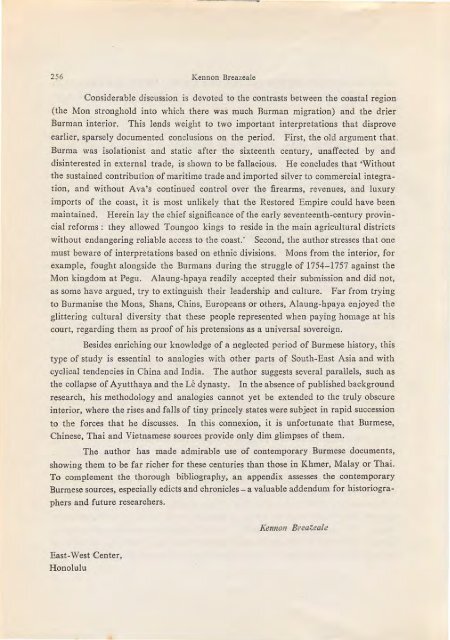The Journal of the Siam Society Vol. LXXII, Part 1-2, 1984 - Khamkoo
The Journal of the Siam Society Vol. LXXII, Part 1-2, 1984 - Khamkoo
The Journal of the Siam Society Vol. LXXII, Part 1-2, 1984 - Khamkoo
You also want an ePaper? Increase the reach of your titles
YUMPU automatically turns print PDFs into web optimized ePapers that Google loves.
256 Kennon Breazeale<br />
Considerable discussion is devoted to <strong>the</strong> contrasts between <strong>the</strong> coastal region<br />
(<strong>the</strong> Mon stronghold into which <strong>the</strong>re was much Burman migration) and <strong>the</strong> drier<br />
Burman interior. This lends weight to two important interpretations that disprove<br />
earlier, sparsely documented conclusions on <strong>the</strong> period.<br />
First, <strong>the</strong> old argument that.<br />
Burma was isolationist and static after <strong>the</strong> sixteenth century, unaffected by and<br />
disinterested in external trade, is shown to be fallacious. He concludes that 'Without<br />
<strong>the</strong> sustained contribution <strong>of</strong> maritime trade and imported silver to commercial integration,<br />
and without Ava's continued control over <strong>the</strong> firearms, revenues, and luxury<br />
imports <strong>of</strong> <strong>the</strong> coast, it is most unlikely that <strong>the</strong> Restored Empire could have been<br />
maintained. Herein lay <strong>the</strong> chief significance <strong>of</strong> <strong>the</strong> early seventeenth-century provincial<br />
reforms : <strong>the</strong>y allowed Toungoo kings to reside in <strong>the</strong> main agricultural districts<br />
without endangering reliable access to <strong>the</strong> coast.' Second, <strong>the</strong> author stresses that one<br />
must beware <strong>of</strong> interpretations based on ethnic divisions. Mons from <strong>the</strong> interior, for<br />
example, fought alongside <strong>the</strong> Burmans during <strong>the</strong> struggle <strong>of</strong> 1754-1757 against <strong>the</strong><br />
Mon kingdom at Pegu. Alaung-hpaya readily accepted <strong>the</strong>ir submission and did not,<br />
as some have argued, try to extinguish <strong>the</strong>ir leadership and culture. Far from trying<br />
to Burmanise <strong>the</strong> Mons, Shans, Chins, Europeans or o<strong>the</strong>rs, Alaung-hpaya enjoyed <strong>the</strong><br />
glittering cultural diversity that <strong>the</strong>se people represented when paying homage at his<br />
court, re_garding <strong>the</strong>m as pro<strong>of</strong> <strong>of</strong> his pretensions as a universal sovereign.<br />
Besides enriching our knowledge <strong>of</strong> a neglected period <strong>of</strong> Burmese history, this<br />
type <strong>of</strong> study is essential to analogies with o<strong>the</strong>r parts <strong>of</strong> South-East Asia and with<br />
cyclical tendencies in China and India. <strong>The</strong> author suggests several parallels, such as<br />
<strong>the</strong> collapse <strong>of</strong> Ayutthaya and <strong>the</strong> Le dynasty. In <strong>the</strong> absence <strong>of</strong> published background<br />
research, his methodology and analogies cannot yet be extended to <strong>the</strong> truly obscure<br />
interior, where <strong>the</strong> rises and falls <strong>of</strong> tiny princely states were subject in rapid succession<br />
to <strong>the</strong> forces that he discusses. In this connexion, it is unfortunate that Burmese,<br />
Chinese, Thai and Vietnamese sources provide only dim glimpses <strong>of</strong> <strong>the</strong>m.<br />
<strong>The</strong> author has made admirable use <strong>of</strong> contemporary Burmese documents,<br />
showing <strong>the</strong>m to be far richer for <strong>the</strong>se centuries than those in Khmer, Malay or Thai.<br />
To complement <strong>the</strong> thorough bibliography, an appendix assesses <strong>the</strong> contemporary<br />
Burmese sources, especially edicts and chronicles- a valuable addendum for historiographers<br />
and future researchers.<br />
Ken/lOll B1·eazeale<br />
East-West Center,<br />
Honolulu

















